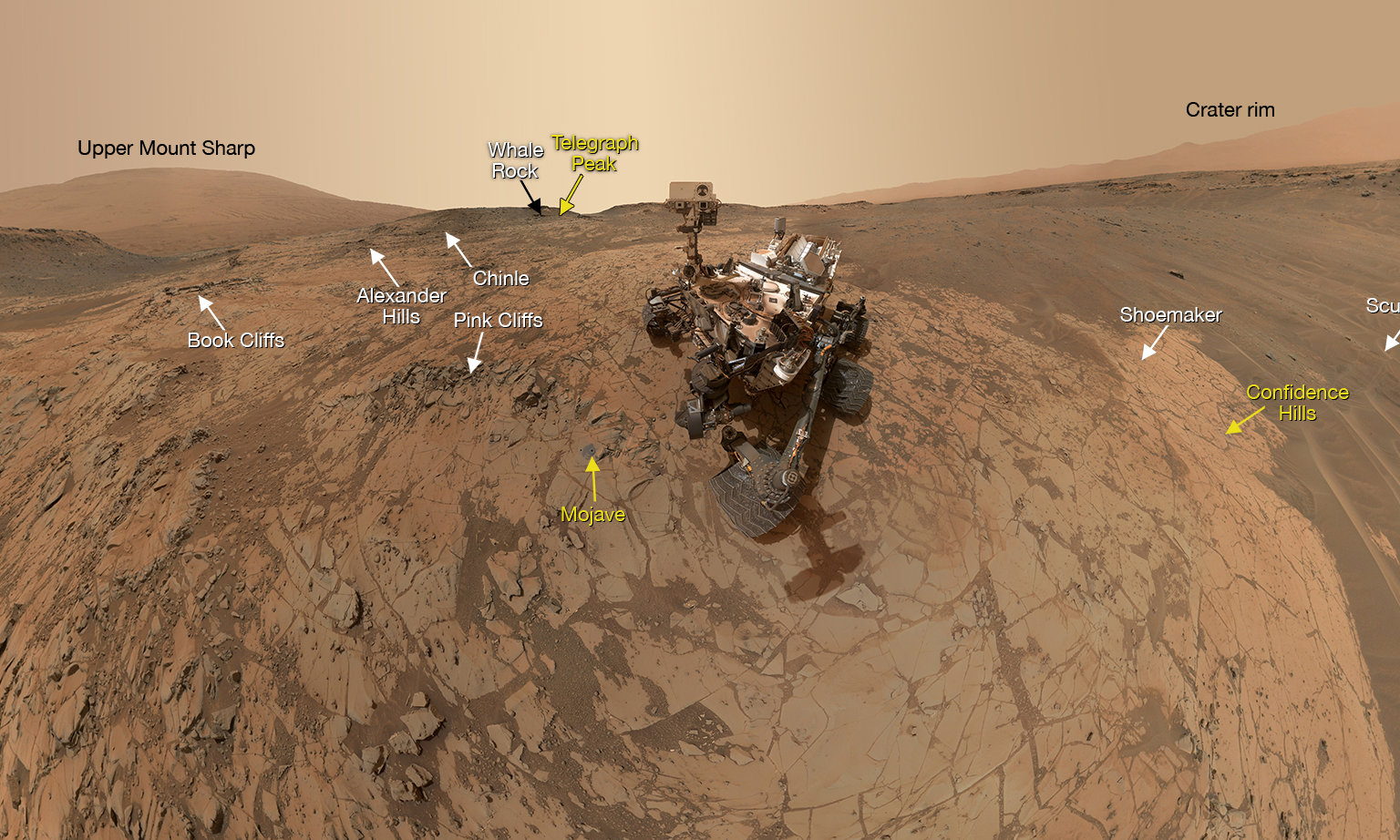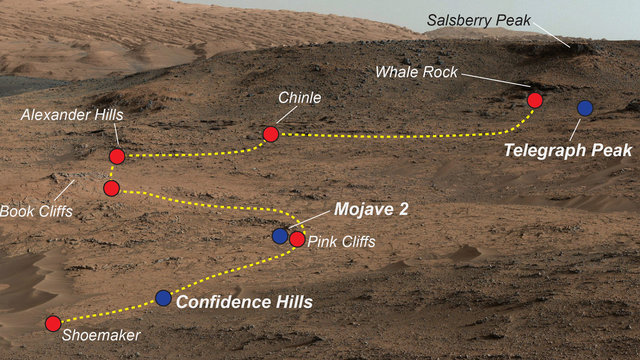NASA's Curiosity Rover Traces Ancient Environmental Changes on Mars

What is history of the climate on Mars, and what were the conditions like long ago, before the Red Planet lost its atmosphere? Were they possibly favorable for life to have taken hold?
Data gathered by NASA's Curiosity rover over the past five years have allowed scientists to construct a detailed portrait of the history of Gale Crater and the lowermost layers of Mount Sharp where the rover has been traversing. Rocks studied during the mission have shown that this site was once a muddy lakebed, filled with water.
The latest research suggests with even more certainty that this was once likely a habitable environment. The diversity of minerals in the rock samples collected by Curiosity are also revealing details about the ancient environmental changes that occurred as Mars started to shed its atmosphere millions of years ago and much of the water on the planet's surface was lost to space.
"We went to Gale Crater to investigate these lower layers of Mount Sharp that have these minerals that precipitated from water and suggest different environments," said Elizabeth Rampe, a NASA exploration mission scientist at Johnson Space Center and lead author of a new study, in a press statement. "These layers were deposited about 3.5 billion years ago, coinciding with a time on Earth when life was beginning to take hold. We think early Mars may have been similar to early Earth, and so these environments might have been habitable."
The researchers looked specifically at four samples that were collected from the lower layers of Mount Sharp using the rover's drill and studied with the onboard chemistry lab, the Chemistry and Mineralogy (CheMin) instrument. They looked specifically at the mineralogy of a layered mudstone called lacustrine, which is formed by lake sedimentation. (On Earth, lacustrine environments are a major contributor of petroleum source rocks.)
RELATED: Volcanic Activity on Ancient Mars May Have Produced Organic Life
A rock's various layers can tell the story of the geologic and climate history of Mars, yielding information about the planet's past likelihood of habitability. Determining what minerals can be found in the layers of Martian sedimentary rock can also yield much data about the environment in which they formed.
Get the Space.com Newsletter
Breaking space news, the latest updates on rocket launches, skywatching events and more!
The team said that the minerals found in the four different samples vary widely within the various layers of the rocks, which suggests that several different environments were present in ancient Gale Crater. There is evidence for waters with different pH and other varying conditions.
At the base are minerals that are volcanic in origin that are rich in iron and magnesium, similar to basalts in Hawaii. Moving higher in the section, scientists saw more silica-rich minerals. In the Telegraph Peak sample, scientists found minerals similar to quartz. In the Buckskin sample, scientists found tridymite. Tridymite is found on Earth, for example, in rocks that formed from partial melting of Earth's crust or in the continental crust. Scientists say this is a strange finding because Mars never had plate tectonics.

In the Confidence Hills and Mojave 2 samples, scientists found clay minerals, which generally form in the presence of liquid water with a near-neutral pH, and therefore could be good indicators of past environments that were conducive to life. The other mineral discovered here was jarosite, a salt that forms in acidic solutions. The jarosite finding indicates that there were acidic fluids at some point in time in this region.
Additionally, there are different iron-oxide minerals in the samples, reflecting the oxidation of the rock minerals as they reacted with oxygen. This tells scientists the water in the lake changed over time.
In their paper, published in Earth and Planetary Science Letters, the researchers discuss two hypotheses to explain this mineralogical diversity. The lake waters themselves at the base were oxidizing, so either there was more oxygen in the atmosphere or other factors encouraged oxidation.
Another hypothesis is that the groundwater changed over time, and that the environmental conditions present in the lake and in later groundwater were quite different. But both offered liquid water and a chemical diversity that could have been favorable for microbial life.
RELATED: Mars Astronauts Face Double the Cancer Risk as Previously Estimated, Says Study
"We have all this evidence that Mars was once really wet but now is dry and cold," Rampe said. "Today, much of the water is locked up in the poles and in the ground at high latitudes as ice. We think that the rocks Curiosity has studied reveal ancient environmental changes that occurred as Mars started to lose its atmosphere."
The question is, how long did the water remain on Mars, and was it long enough for life to flourish?
These findings, along with all of the data gathered during Curiosity's mission, are helping to give scientists a full picture of ancient Mount Sharp, where the rocks appear to be made from the silt that settled out from the lakes.
In my book, Incredible Stories From Space: A Behind-the-Scenes Look at the Missions Changing Our View of the Cosmos, Mars Science Laboratory project scientist Ashwin Vasavada explained that the explanation that best fits the "morphology" in this region — that is, the configuration and evolution of rocks and land forms — is that rivers formed deltas as they emptied into a lake. This likely occurred 3.8 to 3.3 billion years ago. The idea is that the rivers delivered sediment that slowly built up the lower layers of Mount Sharp.
RELATED: Mars May Have Been Born in the Asteroid Belt
"The entire lower few hundred meters of Mount Sharp were likely laid down by these river and lake sediments," Vasavada explained. "That means this event didn't take hundreds or thousands of years; it required millions of years for lakes and rivers to be present to slowly build up, millimeter by millimeter, the bottom of the mountain."
For this to be possible, Mars also needed a thicker atmosphere than it has now, and a greenhouse gas composition that Vasavada said they are still working on figuring out.
But then Mars lost its magnetic field as the planet — which is roughly half the size of Earth — cooled off more quickly. Mars subsequently lost its atmosphere and water, which very likely means that any life that was starting to flourish was lost, leaving Mars the dry barren planet it is today.
Vasavada noted that the Curiosity rover landed in exactly the right place, because here in one area is a record of much of the Red Planet's environmental history, including evidence of a major shift in the planet's climate, when the water that once covered Gale Crater with sediment either dried up or was lost to space.
Originally published on Seeker.
Join our Space Forums to keep talking space on the latest missions, night sky and more! And if you have a news tip, correction or comment, let us know at: community@space.com.

Nancy Atkinson is a science journalist and author who works to tell the stories of people involved in space exploration and astronomy. She has written two books about the people behind NASA projects like the Apollo missions and the robotic rovers exploring our solar system, and hosted/worked on several astronomy podcasts. A writer for Universe Today since 2004, Atkinson's work can also be found at The Planetary Society and Ad Astra, the magazine of the National Space Society. Other work can be found at Seeker, New Scientist, Wired.com, Space.com, NASA’s Astrobiology Magazine, Space Times Magazine, and several newspapers in the Midwest.









